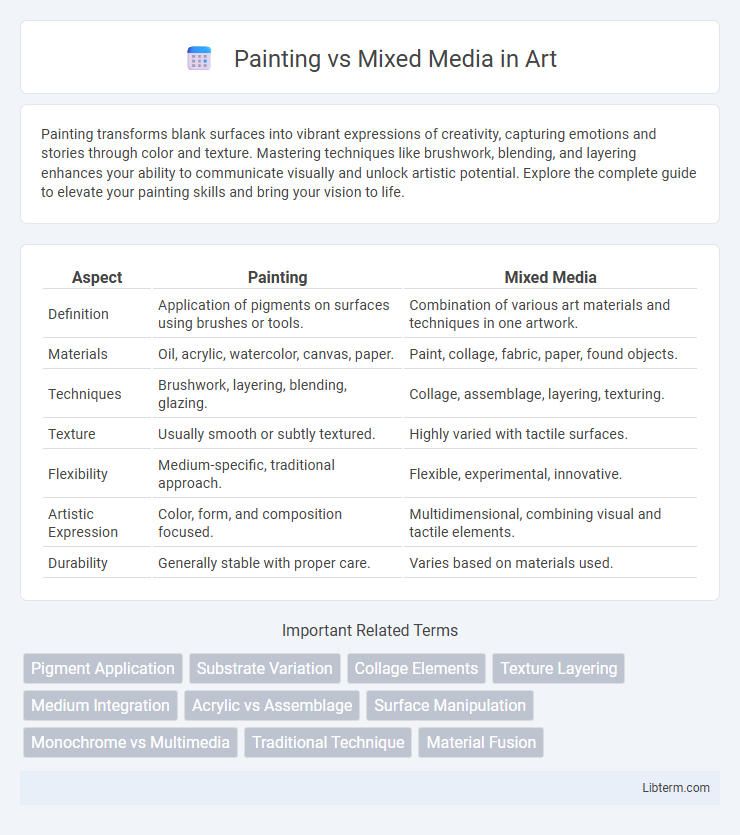Painting transforms blank surfaces into vibrant expressions of creativity, capturing emotions and stories through color and texture. Mastering techniques like brushwork, blending, and layering enhances your ability to communicate visually and unlock artistic potential. Explore the complete guide to elevate your painting skills and bring your vision to life.
Table of Comparison
| Aspect | Painting | Mixed Media |
|---|---|---|
| Definition | Application of pigments on surfaces using brushes or tools. | Combination of various art materials and techniques in one artwork. |
| Materials | Oil, acrylic, watercolor, canvas, paper. | Paint, collage, fabric, paper, found objects. |
| Techniques | Brushwork, layering, blending, glazing. | Collage, assemblage, layering, texturing. |
| Texture | Usually smooth or subtly textured. | Highly varied with tactile surfaces. |
| Flexibility | Medium-specific, traditional approach. | Flexible, experimental, innovative. |
| Artistic Expression | Color, form, and composition focused. | Multidimensional, combining visual and tactile elements. |
| Durability | Generally stable with proper care. | Varies based on materials used. |
Understanding Painting: Definition and Techniques
Painting is the art of applying pigments on a surface such as canvas, wood, or paper using brushes, knives, or sponges to create visually expressive compositions. Key techniques include blending, glazing, impasto, and scumbling, each contributing to texture, depth, and color intensity. Mastery in mediums like oil, acrylic, and watercolor is essential for manipulating drying times and achieving desired effects in painting.
What is Mixed Media Art?
Mixed media art combines various artistic materials and techniques such as paint, ink, collage, fabric, and found objects to create layered and textured compositions. Unlike traditional painting, which primarily uses a single medium like oil or acrylic on canvas, mixed media allows artists to experiment with diverse elements to enhance visual depth and complexity. This approach enables a multifaceted artistic expression, blending tactile and visual components beyond paint alone.
Historical Development of Painting vs Mixed Media
Painting, with origins tracing back to prehistoric cave art around 40,000 years ago, evolved through classical, Renaissance, and modern movements emphasizing oils, watercolors, and acrylics on traditional surfaces. Mixed media emerged prominently in the 20th century, propelled by avant-garde artists like Pablo Picasso and Robert Rauschenberg, who combined painting with collage, photography, and found objects to challenge conventional boundaries. The historical development of mixed media reflects a shift towards experimentation and interdisciplinarity, contrasting with painting's long-standing focus on pigment and brushwork techniques.
Key Distinctions Between Painting and Mixed Media
Painting primarily involves applying pigments to a surface using mediums like oil, acrylic, or watercolor to create images or abstract forms. Mixed media combines painting with other materials such as collage, fabric, found objects, or digital elements, expanding the traditional boundaries of art. The key distinction lies in mixed media's integration of diverse textures and materials, enhancing visual complexity beyond the two-dimensional plane of conventional painting.
Popular Materials Used in Painting and Mixed Media
Popular materials used in painting include acrylics, oils, watercolors, and gouache, prized for their vivid pigmentation and versatility on canvas, paper, or wood surfaces. Mixed media art combines these traditional painting materials with unconventional elements such as fabric, paper, metal, found objects, and digital components to create layered textures and multidimensional effects. The integration of classic painting tools like brushes and palette knives with collage techniques, adhesives, and sculptural materials distinguishes mixed media's dynamic and tactile nature from pure painting.
Creative Freedom: Exploring Limitations and Possibilities
Painting offers a focused medium that allows artists to explore color, texture, and brushwork within defined boundaries, fostering deep mastery of techniques such as oil, acrylic, or watercolor. Mixed media expands creative freedom by merging diverse materials like collage, fabric, and digital elements, enabling experimental combinations that challenge traditional artistic limitations. Both mediums provide unique possibilities for expression, with painting emphasizing refined control and mixed media inviting innovative synthesis and boundary-pushing creativity.
Visual Impact: Texture, Depth, and Color Blending
Painting offers rich texture and depth through techniques like impasto and glazing, allowing smooth or layered color blending to create vivid visual impact. Mixed media enhances texture by incorporating diverse materials such as fabric, paper, and found objects, resulting in complex surface variations and multidimensional depth. Color blending in mixed media can combine traditional paint with unconventional elements, producing unique visual effects that challenge conventional perceptions of space and form.
Suitability for Beginners: Which to Choose?
Painting offers beginners a straightforward introduction to art with a focus on mastering brush techniques, color blending, and composition using traditional tools like acrylics or watercolors. Mixed media provides a more experimental platform where novices can explore combining various materials such as paper, fabric, and paint, fostering creativity through tactile engagement and layering. Choosing between painting and mixed media depends on whether the beginner prefers structured practice or creative exploration to develop foundational skills.
Trends in Contemporary Art: Painting vs Mixed Media
Contemporary art trends show a significant rise in mixed media due to its versatility in combining traditional painting with digital elements, collage, and found objects, appealing to a broader audience seeking multi-sensory experiences. While painting remains a dominant form in galleries, artists increasingly use mixed media to explore complex themes and textures, reflecting the dynamic and interdisciplinary nature of modern art practices. Market analysis reveals a growing collector interest in mixed media pieces for their innovation and unique aesthetic, whereas painting continues to hold value for its historical significance and mastery of technique.
Choosing Your Path: Factors to Consider for Artists
Choosing between painting and mixed media involves evaluating factors such as artistic goals, material preferences, and desired texture effects. Painting offers control over color and form through traditional mediums like oil, acrylic, or watercolor, appealing to artists seeking mastery of technique. Mixed media enables experimentation with diverse materials like paper, fabric, and found objects, attracting creatives interested in dimensionality and unconventional expression.
Painting Infographic

 libterm.com
libterm.com